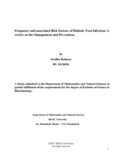Frequency and associated risk factors of diabetic foot infection: a review on the management and prevention
Abstract
Diabetic foot infection (DFI) is a soft tissue or bone infection below the malleoli, leads to lower extremity amputation in 85% of diabetics which results in high-cost hospitalization and a higher mortality risk. Almost 6.3% of people worldwide have diabetic foot infection, patients with type 2 diabetes being the most affected. Peripheral arterial disease (PAD) and diabetic neuropathy are the two main risk factors of diabetic foot but poor sugar control, chronic ulcer, previous lower extremity amputation and lifestyle etc. also play contributing role. Management of DFI starts with proper assessment and that is the key to design an appropriate treatment strategy based on extent and severity of the infection including comorbid conditions. Proper treatment reduces the risk of amputation and infection at the same time improves quality of life as well as health care costs. Though antibiotic therapy and surgical debridement are the most effective way of treating infections but now-a-days several emerging treatments have developed. Diabetic foot infection is preventable. Practicing a healthy lifestyle is must to prevent and control diabetic related foot
diseases. This review aims to summarize major risk factors associated with frequent onset of diabetic foot ulcers with a special emphasis on management and prevention.

